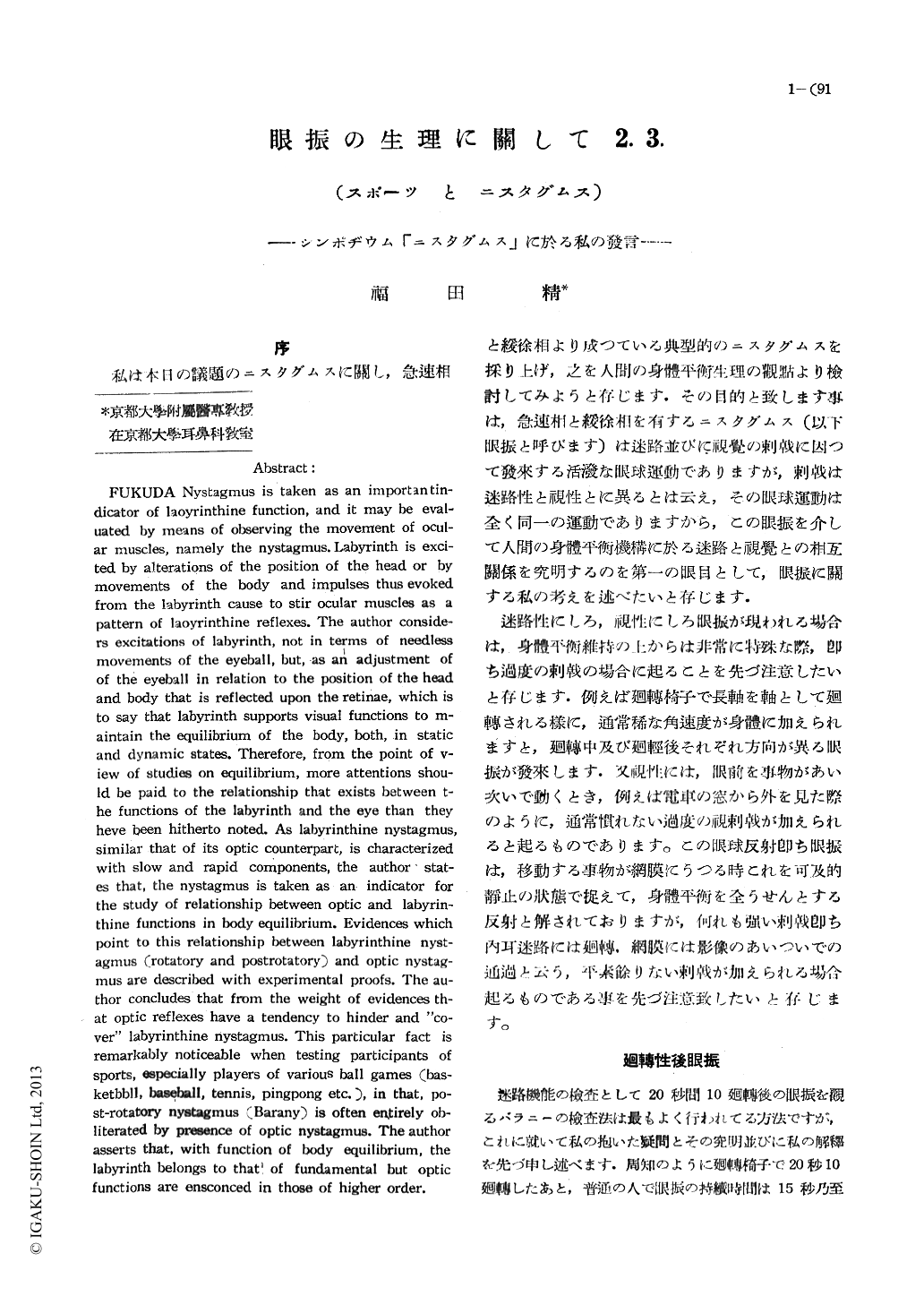- 有料閲覧
- 文献概要
- 1ページ目
序私は本日の議題のニスタグムスに關し,急速相と緩徐相より成つている典型的のニスタグムスを採り上げ,之を人間の身體平衡生理の觀點より検討してみようと存じます.その目的と致します事は,急速相と緩徐相を有するニスタグムス(以下眼振と呼びます)は迷路並びに視覺の刺戟に因って發來する活溌な眼球運動でありますが,刺戟は迷路性と視性とに異るとは云え,その眼球運動は全く同一の運動でありますから,この眼振を介して人間の身體平衡機構に於る迷路と視覺との相互關係を究明するのを第一の眼目として,眼振に關する私の考えを述べたいと存じます.
迷路性にしろ,視性にしろ眼振が現われる場合は,身體平衡維持の上からは非常に特殊な際,即ち過度の刺戟の場合に起ることを先づ注意したいと存じます.例えば廻轉椅子で長軸を軸として廻轉される樣に,通常稀な角速度が身髄に加えられますと,廻轉中及び廻輕後それぞれ方向が異る眼振が發來します.又視性には,眼前を事物があい次いで動くとき,例えば電車の窓から外を見た際のように,通常慣れない過度の視刺戟が加えられると起るものであります。この眼球反射即ち眼振は,移動する事物が網膜にうつる時これを可及的靜止の状態で捉えて,身體平衡を全うせんとする反射と解されておりますが,何れも強い刺戟即ち内耳迷路には廻轉,網膜には影像のあいついでの通過と云う,平素餘りない刺戟が加えられる場合起るものである事を先づ注意致したいと存じます。
FUKUDA Nystagmus is taken as an importantindicator of laoyrinthine function, and it may be evaluated by means of observing the movement of ocular muscles, namely the nystagmus. Labyrinth is excited by alterations of the position of the head or by movements of the body and impulses thus evoked from the labyrinth cause to stir ocular muscles as a pattern of laoyrinthine reflexes. The author considers excitations of labyrinth, not in terms of needless movements of the eyeball, but, as an adjustment of of the eyeball in relation to the position of the head and body that is reflected upon the retinae, which is to say that labyrinth supports visual functions to maintain the equilibrium of the body, both, in static and dynamic states. Therefore, from the point of view of studies on equilibrium, more attentions should be paid to the relationship that exists between the functions of the labyrinth and the eye than they heve been hitherto noted. As labyrinthine nystagmus, similar that of its optic counterpart, is characterized with slow and rapid components, the author states that, the nystagmus is taken as an indicator for the study of relationship between optic and labyrinthine functions in body equilibrium. Evidences which point to this relationship between labyrinthine nystagmus (rotatory and postrotatory) and optic nystagmus are described with experimental proofs. The author concludes that from the weight of evidences that optic reflexes have a tendency to hinder and "cover" labyrinthine nystagmus. This particular fact is remarkably noticeable when testing participants of sports, especially players of various ball games (basketbbll, basetall, tennis, pingpong etc.), in that, post-rotatory nystagmus (Barany) is often entirely obliterated by presence of optic nystagmus. The author asserts that, with function of body equilibrium, the labyrinth belongs to that of fundamental but optic functions are ensconced in those of higher order.

Copyright © 1951, Igaku-Shoin Ltd. All rights reserved.


